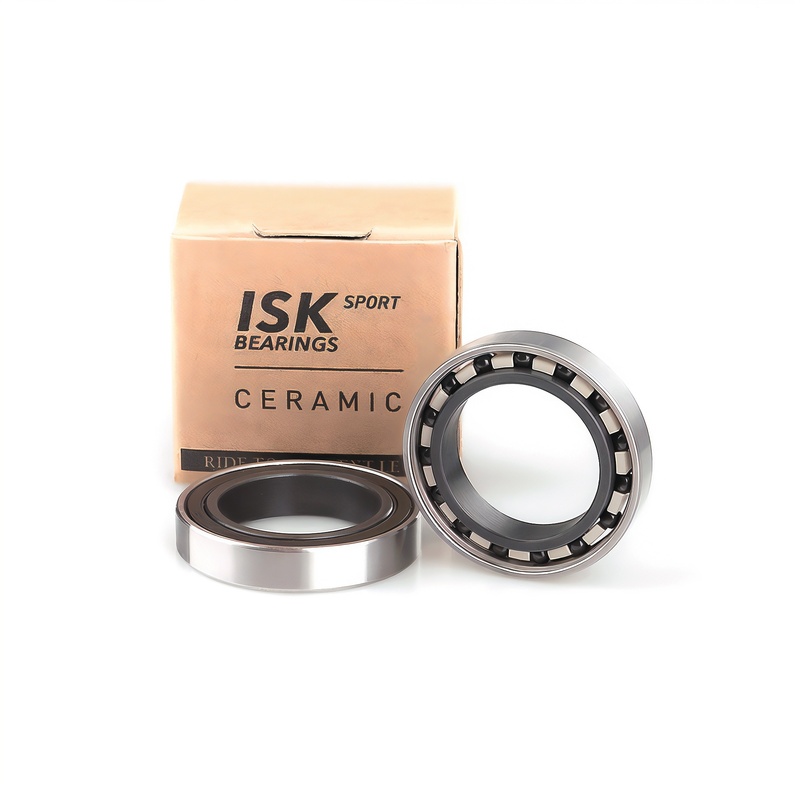Need Support?
Please provide your question. We’ll find you with the best support options.
⬇️ Scroll Down Now or Contact ISK for More Bearing Information
Table of Contents
Ceramic bearings are a special type of bearing primarily made from four main materials: zirconia (ZrO2), silicon nitride (Si3N4), silicon carbide (SiC), and aluminum oxide (Al2O3).
They possess characteristics such as magnetic insulation, resistance to wear, corrosion, and high temperatures, as well as the ability to operate without lubrication. These features make them particularly suitable for applications requiring high temperatures and corrosion resistance.

Hybrid ceramic bearings combine ceramic balls with chromium steel or stainless steel inner and outer rings, balancing the favorable characteristics of ceramics with the durability of steel. They are suitable for high-speed, high-temperature, and corrosive environments, providing better operational performance and durability for industrial equipment, minimizing downtime, and reducing potential losses for companies.
| Susceptible to impacts and extreme thermal stresses | Ceramic bearings are more susceptible to impacts and thermal stresses compared to metal bearings. The brittleness of ceramic materials makes them more prone to fracture under extreme impacts or rapid temperature changes. However, the inherent properties of ceramic materials, such as low friction coefficients and high thermal conductivity, make ceramic bearings well-suited for operating in prolonged high-temperature (or low-temperature) harsh environments. |
| Lower toughness | Ceramic bearings have lower toughness, making them more prone to fracture or damage under extreme loads and impacts. However, this characteristic also gives ceramic materials higher strength and hardness compared to metal bearings. |
| Narrow selection range | Due to the specific properties and limitations of ceramic bearings, their industrial applications are relatively narrower compared to conventional bearings. However, in specific environments such as those requiring corrosion resistance, moisture resistance, and high temperatures, ceramic bearings can be a viable choice. |
Overall, although ceramic bearings possess superior characteristics, it is important to be aware of their drawbacks and limitations when using them. However, ceramic bearings are still applicable in most operating environments. Nonetheless, it is necessary to evaluate and choose based on the specific requirements and conditions of each industry to ensure the normal operation and longevity of the bearings.
Bearing model numbers consist of three parts:
We previously helped an electromechanical equipment manufacturer in Asia resolve abnormal bearing noise issues. By optimizing the sealing structure and adjusting lubrication parameters, we significantly improved system stability and reduced maintenance costs.
Case reference: ISK BEARING Customer Cases
We offer a range of testing and technical services, including independent heat treatment, automated noise & vibration testing, clearance inspection, salt spray testing, and more — helping our clients improve product reliability and performance.
Resource overview: ISK Technical Resources
You can visit the ISK official FAQ section to explore answers related to bearing selection, product specifications, and more.
FAQ Section: ISK Bearings FAQ Center
 Learn More:
Learn More:
Ceramic Bearings: Pioneering High-Performance Technology
Ceramic Bearing Specifications: Overview of Materials and Characteristics
Discover more about the features and applications of various bearings.
Click here to explore more articles and find the perfect bearing for your project.
Needle Bearings (Roller Bearings) are a type of bearing that performs exceptionally well at high speeds. Their rollers are precisely guided by specially shaped, high-rigidity cages with minimal dimensional error. Despite their small cross-section, needle bearings...
How Do Ball Bearings Work? Bearings are often small and unassuming components in a product, yet they are crucial for its proper functioning. Without bearings, many products would fail to operate effectively. But do you know how ball bearings...
Please provide your question. We’ll find you with the best support options.